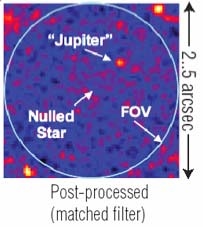|
I am co-investigator of the proposed NASA Discovery mission EPIC. The goal of EPIC is to image and characterize giant extrasolar planets in orbits
with semi-major axes between 2 and 6 AU. EPIC will be able to detect and characterize the atmospheres of planets identified by radial velocity
surveys, to determine orbital inclinations and masses of the detected planets, to characterize the atmospheres of planets around A- and F-stars, and
to observe the inner spatial structure and colors of debris disks.
EPIC will utilize a 1.5 meter off-axis Cassegrain telescope with a surface accruacy of lambda/18. The science instrument is a
visible nulling coronagraph achieving a high contrast of 109 over a 4.84 arcseconds field-of-view with an inner working angle of
0.14 arcseconds and a spectral range from 440 nm to 880 nm. A planet can be observed in several bands with resolutions from 10 to 150
providing a first characterization of detected planets.
The principal investigator is Dr. Mark Clampin, GSFC and the deputy principal investigator is Dr. Gary Melnick, SAO.
 

| Reference: | Clampin, Mark; Melnick, Gary; Lyon, Richard; Kenyon, Scott; Sasselov, Dimitar; Tolls, Volker; Ford, Holland; Golimowski, David; Petro, Larry; Hartig, George; Sparks, William; Illingworth, Garth; Lin, Doug; Seager, Sara; Weinberger, Alycia; Harwit, Martin; Marley, Mark; Schneider, Jean; Shao, Michael; Levine, Marty; Ge, Jian; and Woodruff, Robert; "Extrasolar planetary imaging coronagraph (EPIC);" Space Telescopes and Instrumentation I: Optical, Infrared, and Millimeter. Edited by Mather, John C.; MacEwen, Howard A.; de Graauw, Mattheus W. M.. Proceedings of the SPIE, Volume 6265, pp. 62651B (2006) |
|
|




